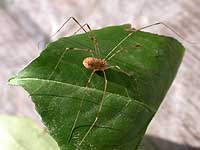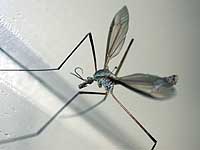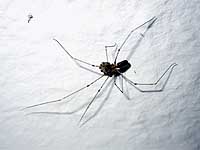Taking the high way through life
By Mark Brazil | Nov 21, 2002
Tall tales of creatures commonly called 'daddy longlegs'If you were an ant, multi-limbed with a ground-hugging body, a trip across the forest floor would present you with a daunting obstacle course. Each fallen twig would be a wall to climb; each wind-blown leaf a teetering trap poised to tip and sluice rainwater; each fallen tree and its tangled branches a mountain range.
What for us would be a mere few strides on a stroll in the woods, is an epic expedition for an ant — and one that must be retraced bearing food back to the nest.
Such thoughts were uppermost in my mind a few weeks back as I sat enjoying an autumn picnic in a forest near my Hokkaido home. A scattering of leaves was rustling down around me; small woodland birds were already associating in their winter flocks, foraging rapidly through the partly leafless canopy; high overhead, sharp calls indicated the passage of bull-necked hawfinches en route to warmer, more southerly regions.
In that peaceful autumnal setting, there should have been music. Had it been a TV natural history documentary, a balletic soundtrack would have provided soothing juxtaposition to the sounds of rustling leaves. The passage of an ant hurrying nestward would have prompted a rapid flurry of scurrying notes, but soft pit-pat, pit-pat notes would have picked up the imagined dainty tip-toeing of another creature, an extraordinary animal that lives out its entire life on stilts — a harvestman (aka daddy longlegs).
Where an ant or beetle would have made an arduous journey traveling over and under, round and past the newly fallen leaf-and-twig litter, the harvestman would stroll robotically across the lot — and at speed — as if disdainful of the effort other creatures make. Size for size, a harvestman’s body is akin to that of a large wood ant or ladybug, but there any resemblance ends.
This mincing octopod is related to the spiders (though the body segments are fused into one), but even spiders are less well endowed with limbs. Imagine your own body, not with four, but with eight long limbs. Not long like a gibbon’s arms are long, but long as in six of your limbs being about 6 meters long, and the other two extending 8 meters or more — each like a slender, flexible and jointed carbon-fiber pole, radiating out from your body in all directions.
Controlling such a network of limbs sounds mind-bogglingly complex. What was that play order: 1,5,2,6,3,7,4,8 . . . or was it 1,8,2,7,3,6,4,5? Don’t even think about it, or you’ll fall over. I already trip over two of my own limbs often enough, but perhaps with eight it’s easier.
The harvestman’s body is perched as if on an air cushion, atop this eight-pointed star of legs. The two longest limbs serve for support and for sensory perception, like search-and-quest antennae for touch. The harvestman’s body is raised so high that it can cruise along like some bizarre battlefield droid from Star Wars.
The harvestmen belong to the order Opilones, a group of 5,000 or so species in the Arachnida — a group whose members are among the oldest terrestrial creatures. The earliest arachnidan fossils that have so far been found date from way back in the Silurian Period more than 417 million years ago.
Nowadays, most Opilones live in tropical areas of Southeast Asia and South America, but there are plenty more that live in temperate regions, and even up into the sub-Arctic. They are predators that bend down from their lofty vantage points to eat smaller invertebrates and to scavenge dead animals.
The common names for harvestmen cause endless confusion, as they vary widely from country to country and region to region. Often, too, a name used for one species in one area shows up in the vernacular for another species elsewhere — which is why biologists rely on those binomial scientific names. The harvestmen go by the common name daddy longlegs, but the same name is also commonly applied to the equally long-limbed crane fly (whose larvae, commonly called leatherjackets, munch on grass roots and often become food for foraging flocks of starlings), and to another group of spiders entirely, those of the genus Pholcus.
Their long-limbed resemblance aside, these three are not close relatives. The crane fly is in fact a dipteran, a two-winged fly, while the third daddy longlegs is an egg-carrying spider. Harvestmen differ from true spiders in that they do not have a narrow waist linking the two parts of their body, but instead the body is fused into an egg-shape.
Autumn is the time to see harvestmen. Their name presumably pertains to these stilt-walkers becoming conspicuous around the time when the harvest moon appears and the northern hemisphere’s harvest is due. During this season, they can be found in pairs and even groups, since perhaps for them it is the courtship season.
But have no fear when the harvestmen are near. The urban myth that the daddy longlegs is “the world’s most poisonous animal” is completely unfounded. They do have glands that give off an acrid scent, presumably in their defense, but that is all. They produce no poisonous toxins; nor are they venomous. In fact they don’t even bite, and so pose no threat to human beings — other than to the peace of mind of arachnophobics.



